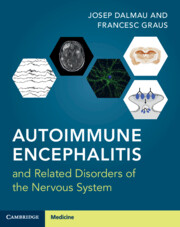Book contents
- Autoimmune Encephalitis and Related Disorders of the Nervous System
- Autoimmune Encephalitis and Related Disorders of the Nervous System
- Copyright page
- Dedication
- Contents
- Clinical Vignettes
- Videos
- Preface
- Abbreviations
- Section 1 Overview
- Section 2 Antibodies and Antigens
- Section 3 Specific Syndromes and Diseases
- Chapter 6 Limbic Encephalitis
- Chapter 7 Autoimmunity Against Proteins Associated with Voltage-Gated Potassium Channels
- Chapter 8 Anti-NMDAR Encephalitis
- Chapter 9 Seizures and Antibodies Against Surface Antigens
- Chapter 10 Acute Disseminated Encephalomyelitis and Myelin Oligodendrocyte Glycoprotein Antibody-Associated Disease
- Chapter 11 Neuromyelitis Optica Spectrum Disorders and Glial Fibrillary Acidic Protein Autoimmunity
- Chapter 12 Autoimmune Cerebellar Ataxias
- Chapter 13 Autoimmune Brainstem Encephalitis
- Chapter 14 Autoimmunity Against the Inhibitory Synapsis
- Chapter 15 Anti-IgLON5 Disease
- Chapter 16 Autoimmune and Inflammatory Encephalopathies as Complications of Cancer
- Chapter 17 Deconstructing Hashimoto Encephalopathy
- Chapter 18 CNS Syndromes at the Frontier of Autoimmune Encephalitis
- Section 4 Autoimmunity in Neurological and Psychiatric Diseases
- Index
- References
Chapter 15 - Anti-IgLON5 Disease
from Section 3 - Specific Syndromes and Diseases
Published online by Cambridge University Press: 27 January 2022
- Autoimmune Encephalitis and Related Disorders of the Nervous System
- Autoimmune Encephalitis and Related Disorders of the Nervous System
- Copyright page
- Dedication
- Contents
- Clinical Vignettes
- Videos
- Preface
- Abbreviations
- Section 1 Overview
- Section 2 Antibodies and Antigens
- Section 3 Specific Syndromes and Diseases
- Chapter 6 Limbic Encephalitis
- Chapter 7 Autoimmunity Against Proteins Associated with Voltage-Gated Potassium Channels
- Chapter 8 Anti-NMDAR Encephalitis
- Chapter 9 Seizures and Antibodies Against Surface Antigens
- Chapter 10 Acute Disseminated Encephalomyelitis and Myelin Oligodendrocyte Glycoprotein Antibody-Associated Disease
- Chapter 11 Neuromyelitis Optica Spectrum Disorders and Glial Fibrillary Acidic Protein Autoimmunity
- Chapter 12 Autoimmune Cerebellar Ataxias
- Chapter 13 Autoimmune Brainstem Encephalitis
- Chapter 14 Autoimmunity Against the Inhibitory Synapsis
- Chapter 15 Anti-IgLON5 Disease
- Chapter 16 Autoimmune and Inflammatory Encephalopathies as Complications of Cancer
- Chapter 17 Deconstructing Hashimoto Encephalopathy
- Chapter 18 CNS Syndromes at the Frontier of Autoimmune Encephalitis
- Section 4 Autoimmunity in Neurological and Psychiatric Diseases
- Index
- References
Summary
Anti-IgLON5 disease is a neurological disorder that associates with antibodies against IgLON5, a neuronal cell-adhesion protein of unknown function. Most patients develop a combination of prominent sleep alterations (non-rapid eye movement (NREM) and REM parasomnias with obstructive sleep apnoeas), bulbar dysfunction (dysarthria, dysphagia, vocal cord palsy, or episodes of respiratory failure), and gait instability. Initial autopsy studies showed deposits of phosphorylated tau protein predominantly in neurons of the tegmentum of the brainstem, suggesting a primary neurodegenerative disease. However, findings in subsequent studies have provided increasing support to an immune-mediated pathogenesis. First, there is a strong association with the human leukocyte antigen (HLA) haplotype DRB1*10:01–DQB1*05:01 which is present in ~60% of patients (compared to 2% in the normal population); second, recent autopsy studies showed absence of abnormal deposits of tau; and third, in live neurons in culture, IgLON5 antibodies cause an irreversible loss of surface IgLON5 clusters and changes in the cytoskeleton such as dystrophic neurites and axonal swellings. Taken together, these studies suggest that an antibody-mediated disruption of IgLON5 function leads to neurofilament and cytoskeletal alterations that can potentially result in tau accumulation.
Keywords
- Type
- Chapter
- Information
- Publisher: Cambridge University PressPrint publication year: 2022

